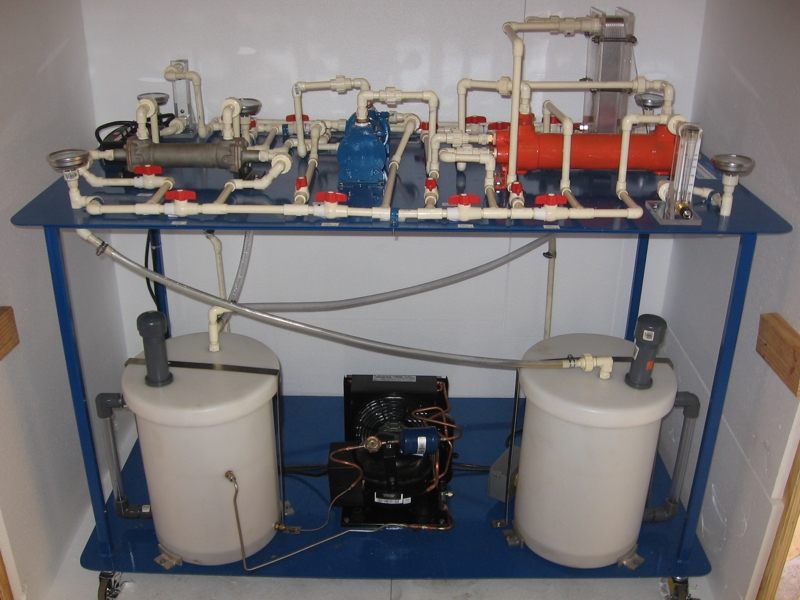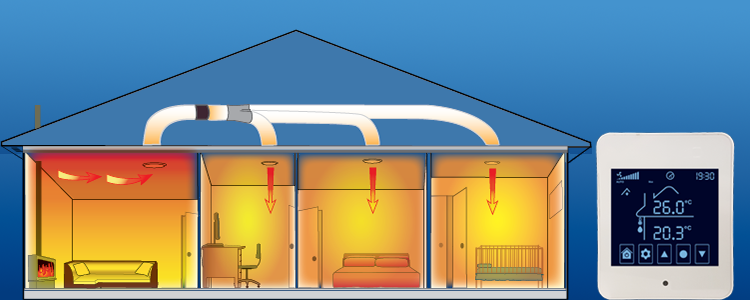The Function of Heat Transfer Systems in Sustainable Power Solutions for the Future
Heat transfer systems are important in the pursuit for lasting energy remedies. They maximize thermal power administration, enhancing the performance of eco-friendly technologies. By utilizing devices like radiation, convection, and transmission, these systems decrease power losses. Their duty in solar thermal and geothermal applications is specifically substantial. As innovations emerge, the potential for additional advancements increases crucial inquiries regarding future power techniques. What developments will form the landscape of sustainable power?
Recognizing Heat Transfer Equipments

The Significance of Thermal Power Monitoring
Reliable thermal energy administration is necessary for optimizing energy performance and reducing waste in different systems. By managing temperature and enhancing Heat transfer procedures, organizations can markedly lower power consumption and functional prices. Effective administration entails the execution of sophisticated innovations and practices that keep an eye on and manage thermal problems within systems, making certain that energy resources are used effectively. In enhancement, proper thermal energy administration contributes to lowering greenhouse gas discharges, aligning with worldwide sustainability goals. It also boosts system dependability and efficiency, causing boosted item quality and longer tools life-span. Inevitably, focusing on thermal power management is a crucial action towards producing much more lasting energy services and promoting an accountable method to energy usage in commercial and property contexts.
Applications of Heat Transfer in Renewable Resource
While various renewable power resources promise sustainability, the reliable application of Heat transfer plays a crucial role in their performance. In wind power systems, Heat transfer is made use of for wind turbine element cooling, boosting efficiency and longevity. Geothermal energy relies upon reliable Heat exchange in between the planet's subsurface and the liquid distributing in the system, maximizing power extraction. Biomass power processes additionally gain from Heat transfer, as it assists in converting natural materials into useful fuel with pyrolysis and gasification. Furthermore, in hydropower, keeping perfect temperatures in storage tanks can boost power output. Each of these applications demonstrates the vital importance of Heat transfer systems in enhancing renewable resource innovations, inevitably adding to a much more sustainable energy future.
Enhancing Solar Thermal Power Effectiveness
As solar thermal power systems remain to advance, boosting their efficiency has actually come to be essential for taking full advantage of energy outcome. Advances in Heat transfer modern technologies, such as enhanced thermal storage materials and innovative Heat exchangers, play a considerable function in enhancing efficiency. By utilizing sophisticated products that have remarkable thermal conductivity, systems can move and catch Heat a lot more properly. In addition, incorporating monitoring systems that follow the sunlight's course assurances that enthusiasts receive excellent solar exposure throughout the day. Using nanotechnology in solar absorbers can better increase energy absorption rates. Including automated control systems aids control temperature levels and handle power distribution successfully, leading to decreased losses and boosted overall system performance. These enhancements lead the way for even more sustainable solar thermal energy solutions in the future.
Geothermal Heating: A Sustainable Remedy
Geothermal home heating offers a feasible choice for sustainable energy, offering substantial ecological advantages with minimized greenhouse gas emissions. Its efficiency and cost-effectiveness make it an attractive choice to traditional home heating systems. Obstacles related to application should be addressed to optimize its potential effect.
Ecological Advantages of Geothermal
Typical home heating methods add considerably to greenhouse gas exhausts, geothermal home heating presents an engaging choice that decreases ecological influence. By taking advantage of the Planet's internal Heat, geothermal systems make use of a renewable resource resource, significantly lowering reliance on nonrenewable fuel sources. This technique generates marginal carbon exhausts, making it a cleaner option for property and industrial heating. In addition, geothermal systems advertise energy performance, as they need less power compared to conventional furnace. DVS Heat Transfer Systems. The use of geothermal power additionally helps in decreasing air pollution, improving regional air top quality and public wellness. As a lasting remedy, geothermal home heating supports climate change mitigation efforts, positioning itself as a vital Continued part in the change in the direction of a greener future
Effectiveness and Cost-Effectiveness
How does geothermal heating measure up in regards to performance and cost-effectiveness contrasted to standard heating unit? Geothermal heating demonstrates premium effectiveness, usually achieving a coefficient of performance (COP) of 3 to 5, meaning it generates three to 5 units of Heat for each system of electrical power taken in. This effectiveness translates right into reduced operating expense, specifically in areas with steady geothermal resources. Initial installment expenses can be greater than conventional systems; nevertheless, long-term savings on power bills and reduced maintenance expenditures can offset these in advance financial investments. In addition, several governments incentivize geothermal systems with refunds and tax credit scores, improving their cost-effectiveness. On the whole, geothermal home heating becomes a financially viable and lasting alternative to even more conventional heating services.
Application Difficulties and Solutions
Various challenges can restrain the extensive execution of geothermal furnace, despite their clear advantages as a lasting energy option. High initial installation costs usually deter financiers and house owners, making funding a considerable obstacle. Additionally, the geographical limitations of suitable geothermal sites restrict availability in specific areas. Local policies and allowing processes can also make complex task growth, causing hold-ups. Furthermore, public recognition and understanding of geothermal systems continue to be reduced, preventing approval. To attend to these obstacles, targeted education and learning campaigns can improve open secret, while government incentives could relieve economic burdens. Collaborating with local authorities to enhance regulations may assist in smoother job approvals, ultimately promoting the adoption of geothermal heating as a sensible, lasting energy option.
Developments in Heat Transfer Technologies
Advancements in Heat transfer technologies play an essential function in enhancing power efficiency and sustainability. Advanced Heat exchangers and stage adjustment materials are at the center of these growths, supplying substantial renovations in thermal monitoring. These modern technologies not just maximize energy usage yet also contribute to minimizing environmental impact in numerous applications.
Advanced Heat Exchangers
Advanced Heat exchangers play a vital duty in improving power performance across different applications in lasting energy remedies. These devices facilitate the transfer of Heat in between 2 or even more liquids, significantly decreasing power consumption in procedures such as commercial heating, air conditioning, and power generation. Developments in products and design, such as using nanofluids and small configurations, have actually resulted in improved thermal performance and minimized size needs. In addition, developments in electronic monitoring and control systems enable maximized procedure, additional boosting efficiency. By decreasing waste Heat and making best use of power recovery, advanced Heat exchangers add to lower carbon footprints and sustain the shift towards eco-friendly technologies. Their proceeded development is essential for achieving worldwide power sustainability goals.
Stage Adjustment Materials
The assimilation of stage adjustment products (PCMs) right into Heat transfer technologies stands for a substantial improvement in energy management and effectiveness. PCMs absorb and release thermal power during their stage modifications, enabling effective temperature level law in structure materials and power systems. By saving excess Heat throughout height durations and launching it when need boosts, PCMs contribute to load changing and power preservation - DVS Heat Transfer Systems. This capacity enhances the efficiency of renewable power systems, especially in solar thermal applications. Furthermore, PCMs can improve the thermal convenience of indoor atmospheres, lowering imp source reliance on traditional heating and cooling down methods. As innovations in PCM solutions proceed to emerge, their duty in sustainable energy options is poised to expand, offering promising methods for future research and application

Future Potential Customers for Heat Transfer in Lasting Energy
As the need for lasting power options remains to climb, the duty of Heat transfer systems is coming to be significantly critical in forming future try this modern technologies. Developments in layouts and materials are expected to enhance performance in Heat transfer, minimizing power losses in different applications. The combination of sophisticated thermal storage space systems, such as stage modification materials and thermochemical storage, will certainly make it possible for far better administration of power sources. Research study right into nanofluids and biomimetic Heat exchangers may additionally maximize thermal performance. The fostering of wise technologies will certainly permit for real-time tracking and adaptive control of Heat transfer procedures. These innovations are positioned to substantially add to the total effectiveness and sustainability of energy systems, paving the way for a more energy-efficient future.
Regularly Asked Inquiries
Exactly How Can Individuals Implement Heat Transfer Equipment in the house?

Individuals can implement Heat transfer systems at home by mounting energy-efficient devices, using radiant heating, and maximizing insulation. These procedures boost energy effectiveness, minimize expenses, and promote lasting practices in residential settings.

What Are the Prices Related To Setting Up Heat Transfer Equipments?
The expenses linked with mounting Heat transfer systems differ extensively, typically incorporating equipment, installation labor, and upkeep. Aspects such as system type, home size, and regional policies considerably influence the overall expense included.
Are There Federal Government Motivations for Heat Transfer System Installations?
Federal government motivations for Heat transfer system setups differ by area and can include tax gives, credit scores, and discounts. These monetary benefits intend to motivate adoption, ultimately advertising energy performance and decreasing ecological impact within neighborhoods.
How Do Heat Transfer Solutions Impact Power Bills?
Heat transfer systems notably affect power expenses by optimizing power efficiency. By boosting the transfer of Heat, these systems minimize energy consumption, bring about lower energy costs and producing a more sustainable technique to energy monitoring.
What Maintenance Is Required for Heat Transfer Equipments?
Upkeep for Heat transfer systems includes routine inspections, cleaning of parts, checking fluid levels, ensuring appropriate insulation, and changing worn components. These jobs assist keep efficiency, stop breakdowns, and extend the system's functional lifespan.
These systems facilitate the movement of thermal energy from one medium to an additional, making it possible for the transfer of Heat for heating, air conditioning, or power generation functions. Geothermal energy depends on reliable Heat exchange in between the planet's subsurface and the liquid circulating in the system, making best use of energy extraction. Additionally, geothermal systems promote energy efficiency, as they require less energy compared to conventional heating systems. Advanced Heat exchangers play a crucial duty in enhancing power effectiveness across numerous applications in sustainable power options. Heat transfer systems notably influence energy costs by maximizing energy performance.